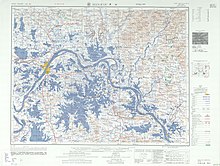Talk:堖
Add topicAppearance
Latest comment: 4 years ago by Geographyinitiative in topic 堖 may be a ghost character
堖 may be a ghost character
[edit]1. 简化字总表
- 第一表: 惱 → 恼, 腦 → 脑
- 第二表: no rule stating that 𡿺 can be simplified to 㐫 in all cases
Also note that 瑙 (U+7459) is left unsimplified in GB 2312 (G0-6827).
2. 通用规范汉字表 (Table of General Standard Chinese Characters)
- 垴: #6776
- 附件1. 规范字与繁体字、异体字对照表 does not list any traditional or variant form for 垴
3. Unicode source references
- U+57B4 垴: G0-5B71, H-996F, T4-285E
- U+5816 堖: G1-5B71 only
G1-#### is meant to be the traditional form of G0-####. But Hong Kong and Taiwan, which use traditional characters, have source references under U+57B4 only, not U+5816. The latter is a G single source character.
In conclusion, (1) it seems that 垴 has been 垴 from the beginning and has never been 堖; (2) 堖 may actually be a ghost character. This entry may need to be moved to 垴.
--2600:1:B1AB:302:683E:43BD:C85C:1F72 22:24, 30 May 2020 (UTC)

Map including T'u-chia-nao-shih 凃家腦市 (AMS, 1953) (no 堖 or 垴) - Xiandai Hanyu Cidian 7th edition page 940 has 垴 (**堖) (凡例: "带两个星号的是该表以外的异体字")
- Xiandai Hanyu Guifan Cidian 3rd edition page 948 has 垴 but no 堖
- Cihai 6th edition page 1644 has only 垴 and no 堖.
- Do not find mention of either form in Taiwan Guoyu Cidian.[1][2]
- --Geographyinitiative (talk) 23:01, 30 May 2020 (UTC)
- Based on the above, at bare minimum this edit: [3] would be more consistent with the way that other characters are handled. --Geographyinitiative (talk) 00:22, 31 May 2020 (UTC)

